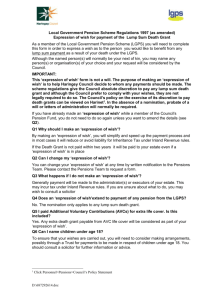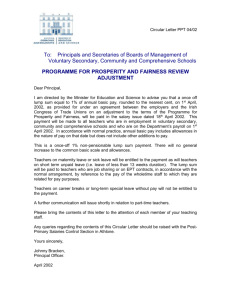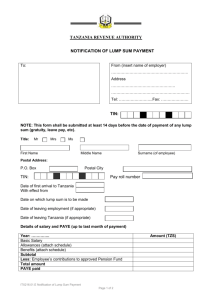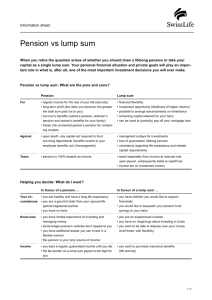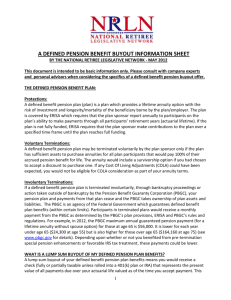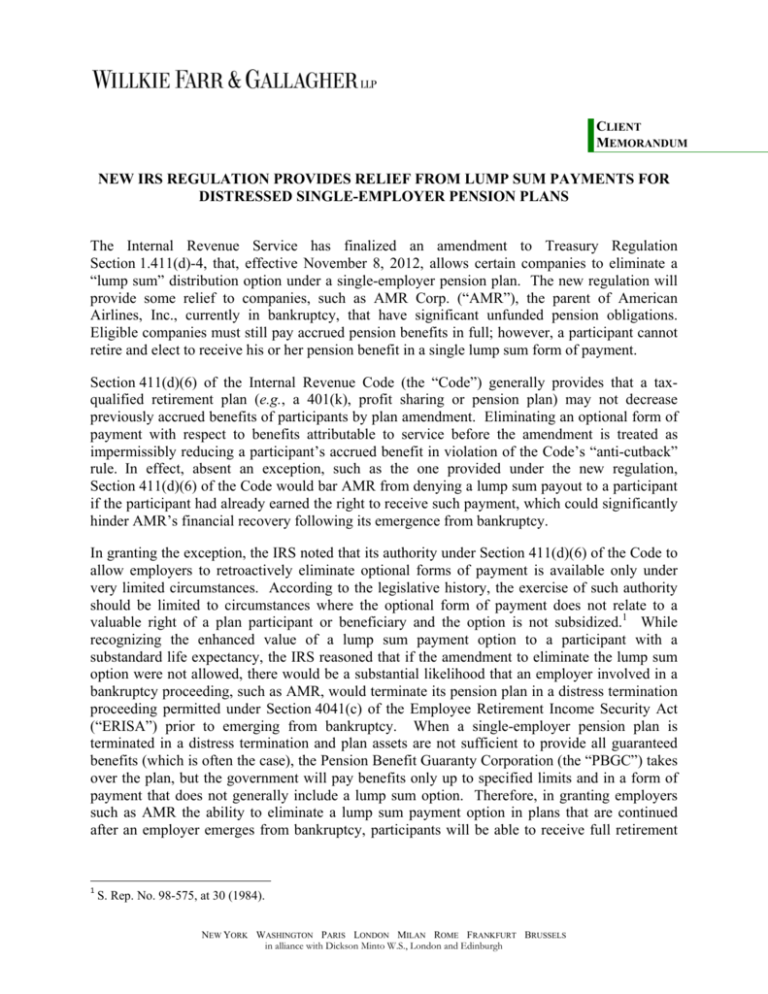
CLIENT
MEMORANDUM
NEW IRS REGULATION PROVIDES RELIEF FROM LUMP SUM PAYMENTS FOR
DISTRESSED SINGLE-EMPLOYER PENSION PLANS
The Internal Revenue Service has finalized an amendment to Treasury Regulation
Section 1.411(d)-4, that, effective November 8, 2012, allows certain companies to eliminate a
“lump sum” distribution option under a single-employer pension plan. The new regulation will
provide some relief to companies, such as AMR Corp. (“AMR”), the parent of American
Airlines, Inc., currently in bankruptcy, that have significant unfunded pension obligations.
Eligible companies must still pay accrued pension benefits in full; however, a participant cannot
retire and elect to receive his or her pension benefit in a single lump sum form of payment.
Section 411(d)(6) of the Internal Revenue Code (the “Code”) generally provides that a taxqualified retirement plan (e.g., a 401(k), profit sharing or pension plan) may not decrease
previously accrued benefits of participants by plan amendment. Eliminating an optional form of
payment with respect to benefits attributable to service before the amendment is treated as
impermissibly reducing a participant’s accrued benefit in violation of the Code’s “anti-cutback”
rule. In effect, absent an exception, such as the one provided under the new regulation,
Section 411(d)(6) of the Code would bar AMR from denying a lump sum payout to a participant
if the participant had already earned the right to receive such payment, which could significantly
hinder AMR’s financial recovery following its emergence from bankruptcy.
In granting the exception, the IRS noted that its authority under Section 411(d)(6) of the Code to
allow employers to retroactively eliminate optional forms of payment is available only under
very limited circumstances. According to the legislative history, the exercise of such authority
should be limited to circumstances where the optional form of payment does not relate to a
valuable right of a plan participant or beneficiary and the option is not subsidized.1 While
recognizing the enhanced value of a lump sum payment option to a participant with a
substandard life expectancy, the IRS reasoned that if the amendment to eliminate the lump sum
option were not allowed, there would be a substantial likelihood that an employer involved in a
bankruptcy proceeding, such as AMR, would terminate its pension plan in a distress termination
proceeding permitted under Section 4041(c) of the Employee Retirement Income Security Act
(“ERISA”) prior to emerging from bankruptcy. When a single-employer pension plan is
terminated in a distress termination and plan assets are not sufficient to provide all guaranteed
benefits (which is often the case), the Pension Benefit Guaranty Corporation (the “PBGC”) takes
over the plan, but the government will pay benefits only up to specified limits and in a form of
payment that does not generally include a lump sum option. Therefore, in granting employers
such as AMR the ability to eliminate a lump sum payment option in plans that are continued
after an employer emerges from bankruptcy, participants will be able to receive full retirement
1
S. Rep. No. 98-575, at 30 (1984). NEW YORK WASHINGTON PARIS LONDON MILAN ROME FRANKFURT BRUSSELS
in alliance with Dickson Minto W.S., London and Edinburgh
benefits, rather than the PBGC’s limited benefit, of equal actuarial value to the lump sum
payment option (based on standard mortality).
In order to eliminate a lump sum option from a single-employer pension plan, the following four
conditions must be satisfied on the later of the date the amendment is adopted or the date it is
made effective:
Actuarial Certification: The enrolled actuary for the pension plan must certify
that the plan’s adjusted funding target attainment percentage (in general, the value
of plan assets relative to plan liabilities) is less than 100 percent for the plan year
that contains the applicable amendment date.
Sponsor in Bankruptcy: The plan sponsor must be a debtor in a bankruptcy case
(i.e., a case under Title 11 of the U.S. Code or a similar federal or state law) and
therefore be prohibited from making lump sum payments during the bankruptcy
proceedings due to the application of the requirements of Section 436(d)(2) of the
Code and Section 206(g)(3)(B) of ERISA.
Bankruptcy Court Approval: The court overseeing the bankruptcy case must
issue an order, after notice to affected parties (i.e., plan participants and
beneficiaries, employee representatives and the PBGC) and a hearing, finding that
the amendment eliminating the lump sum payment option is necessary to avoid a
distress termination of the plan by the plan sponsor pursuant to Section 4041(c) of
ERISA, or an involuntary termination of the plan by the PBGC pursuant to
Section 4042 of ERISA, before the plan sponsor emerges from bankruptcy (or
before the bankruptcy case is otherwise completed).
PBGC Determination: The PBGC must make a determination that the adoption
of the amendment eliminating the lump sum payment option is necessary to avoid
a distress or involuntary termination of the plan before the plan sponsor emerges
from bankruptcy (or before the bankruptcy case is otherwise completed) and that
the plan is not sufficient to provide for guaranteed benefits under ERISA.
Prior to the new rule, distressed companies had few options other than to terminate their
underfunded pension plans, leaving the government responsible for millions, and sometimes
billions, of dollars in unfunded benefits, while participants would often receive less than the full
benefit promised by the plan. The new exception crafted by the IRS is a welcome option that
seeks to balance the interests of plan participants, employers and the government.
***************
If you have any questions concerning the foregoing or would like additional information, please
contact Matthew A. Feldman (212-728-8651, mfeldman@willkie.com), Richard L. Reinhold
(212-728-8292, rreinhold@willkie.com), Peter J. Allman (212-728-8101, pallman@willkie.com)
or the Willkie attorney with whom you regularly work.
-2-
Willkie Farr & Gallagher LLP is headquartered at 787 Seventh Avenue, New York, NY 100196099. Our telephone number is (212) 728-8000 and our facsimile number is (212) 728-8111.
Our website is located at www.willkie.com.
November 28, 2012
IRS Circular 230 disclosure:
To ensure compliance with requirements imposed by the Internal Revenue Service, we inform you that any U.S. tax advice
contained in this communication (including any attachments) is not intended or written to be used, and cannot be used, for the
purpose of (i) avoiding penalties under the Internal Revenue Code or (ii) promoting, marketing or recommending to another party
any transaction or matter addressed herein.
Copyright © 2012 Willkie Farr & Gallagher LLP.
All Rights Reserved. This memorandum may not be reproduced or disseminated in any form without the express permission of
Willkie Farr & Gallagher LLP. This memorandum is provided for news and information purposes only and does not constitute
legal advice or an invitation to an attorney-client relationship. While every effort has been made to ensure the accuracy of the
information contained herein, Willkie Farr & Gallagher LLP does not guarantee such accuracy and cannot be held liable for any
errors in or any reliance upon this information. Under New York’s Code of Professional Responsibility, this material may
constitute attorney advertising. Prior results do not guarantee a similar outcome.
-3-

